Ultrabook Head to Head: Acer Aspire S3 vs. ASUS UX31E
by Jarred Walton & Manveer Wasson on December 21, 2011 5:40 AM ESTUltrabook Application Performance
We’ve really covered most everything that matters, as the core hardware is very similar. By this time you should have a good idea which ultrabook (if any) is right for you, but we still have benchmarks to run. We’ll start with our usual application performance metrics, skip the gaming tests (HD 3000 is sufficient for entry level gaming and that’s about it), and then looks at the battery life and display metrics. All of the ultrabooks we’ve tested have SSDs for storage, which really helps the general application performance; keep in mind that models that opt for an SSD+HDD hybrid solution (like the less expensive Acer S3) won’t have nearly the overall responsiveness. We’d just as soon Intel revise the ultrabook spec to mandate SSD storage only for the OS and apps (e.g. at least a 60GB SSD), but that ship has unfortunately sailed. Anyway, let’s hit the charts, starting with PCMark 7.
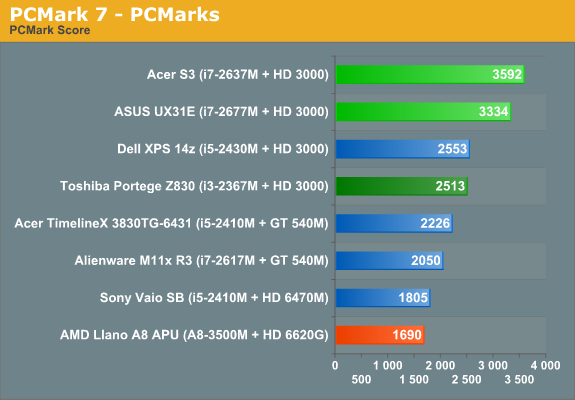

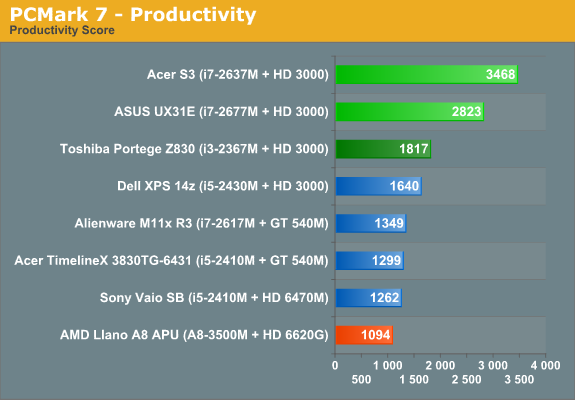
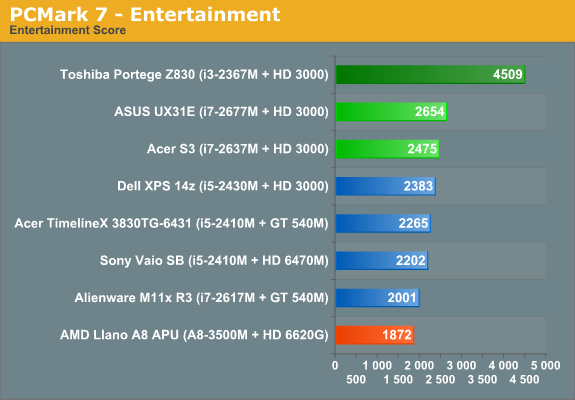

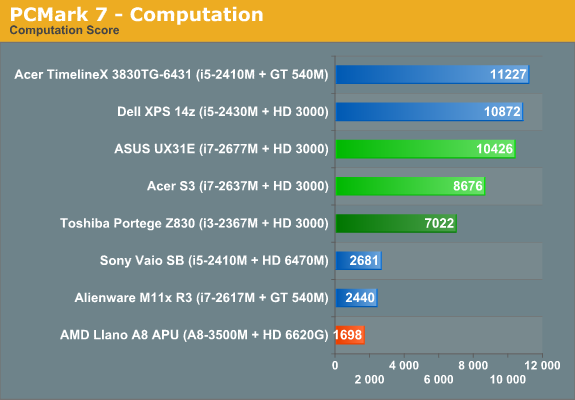
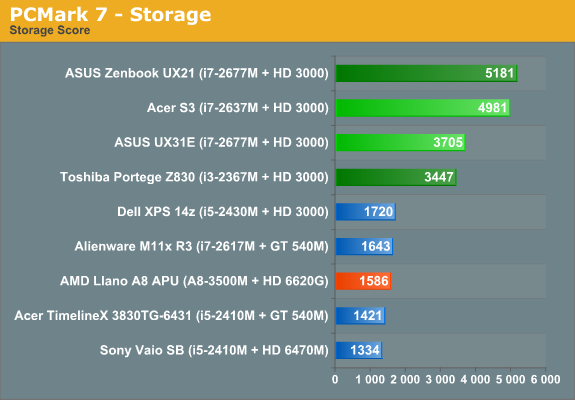
Our full set of PCMark 7 results is the most compelling view of using an ultrabook. They don’t have the raw compute power of a quad-core notebook or even a non-ULV Core i5, but for most tasks the ULV processors are plenty fast. Windows boots and shuts down very quickly, launching multiple applications simultaneously doesn’t grind performance to a halt, and even better you can mostly avoid the long-term performance degradation that usually comes with Windows and conventional hard drives. There are a couple other items of interest to point out with these results. First, the Micron C400 is clearly faster than the SanDisk U100 SSD; this manifests in many of the benchmarks, but the Storage suite in particular shows just how much of a difference there is. Also note that the UX21E we tested had a SandForce 2200 based SSD, and that’s why it also scores well despite only having 128GB (e.g. fewer NAND die). The other item to point out is that the ASUS shipped with newer Intel graphics drivers; usually such things don’t matter much, but here the updated drivers really boost the Quick Sync performance (and thus the Computation score) as well as some of the 3DMark results we’ll see below. Let’s hit the rest of the application benchmarks before we summarize things.
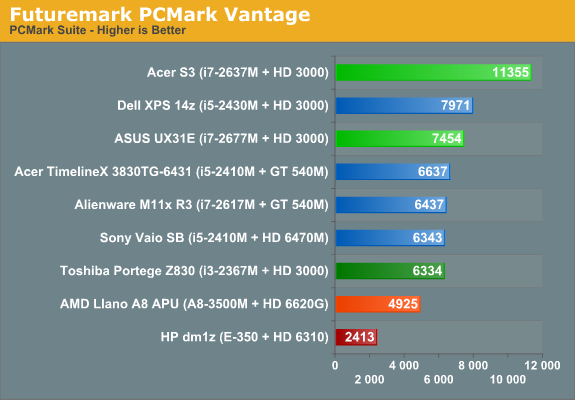
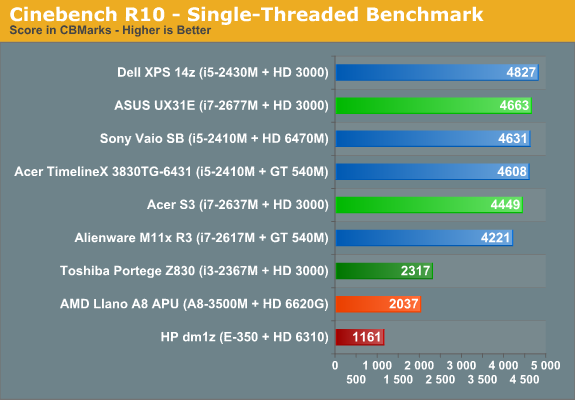
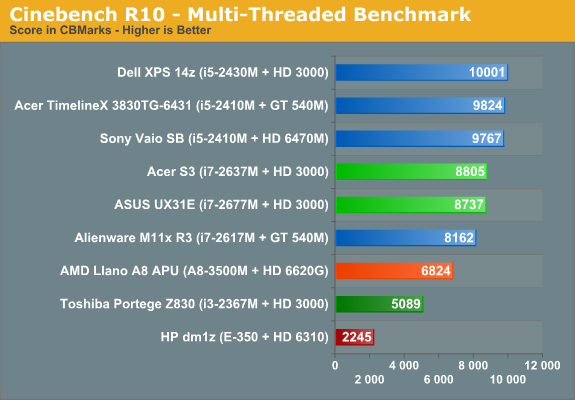
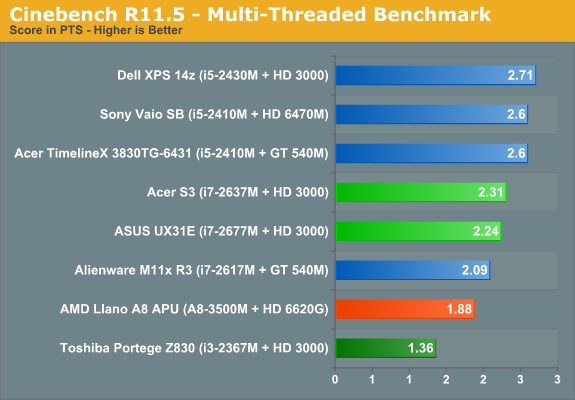
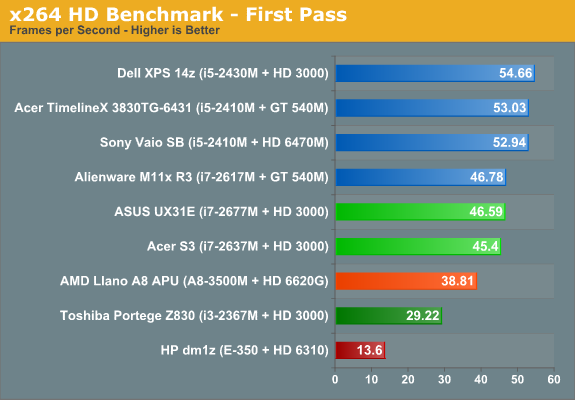
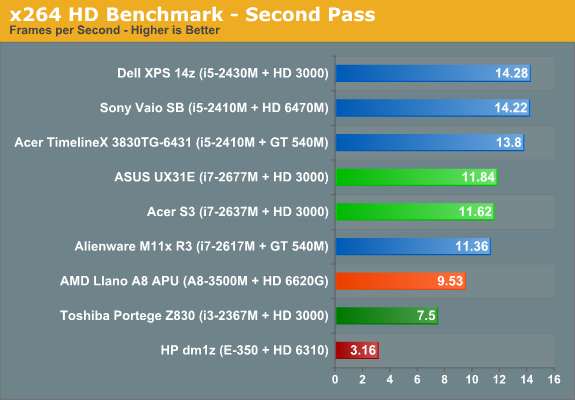
Once we get away from the SSD-centric tests like PCMark (Vantage appears particularly unkind to the SanDisk U100), performance falls out where you’d expect. With the high Turbo Boost modes available on the i7 ULV processors, the S3 and UX31E can actually give the 35W TDP Core i5 parts a run for the money, but if you put a sustained load on the CPU (which most of these tests do) you’ll see the clock speeds drop after the first 30-45 seconds. Generally speaking, even the OEM i5-2410M/2430M are faster than the i7-2677M in most tests, but that’s fine as the ULV parts are at least close and they still use half the power at full load. Taking a look at the AMD side of things, we’ll just skip Brazos—it’s there for reference, and since it ships in 13.3” laptops it’s a fair addition for low-power laptops, albeit one that costs half as much as an ultrabook. Llano on the other hand still comes out okay in performance comparisons; where it was clearly faster than the i3-2367M ULV part in multi-threaded scenarios, the Core i7 ULV parts regain the lead, but that’s not the entire story.
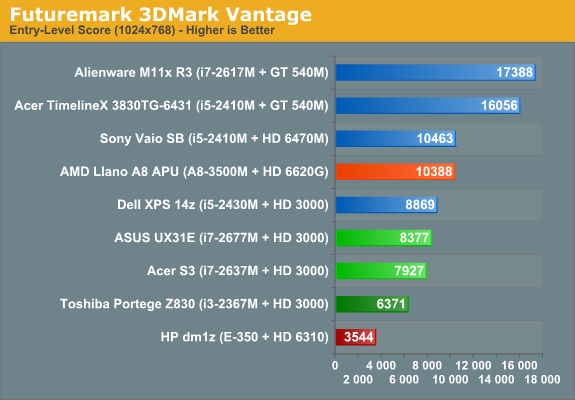
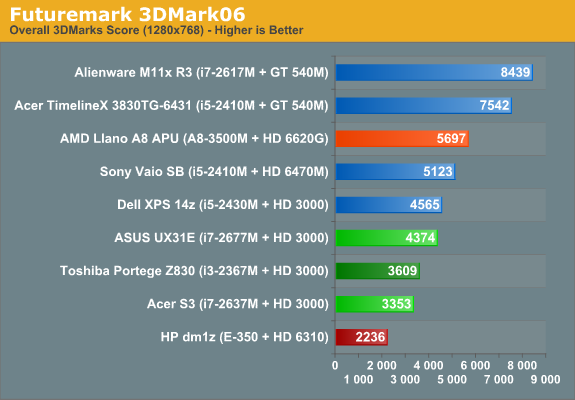
Rounding things out with 3DMark, the three ultrabooks place at the bottom of the charts. They’re faster than the E-350 IGP, but that part competes in a completely different price range so that’s okay; Llano on the other hand puts paid to anything without a discrete GPU. We’d still like to see A8-series APUs in laptops costing under $600, and Llano uses more power than the ULV chips and goes into thicker, better cooled laptops. Still, it’s a great budget laptop part if you care more about graphics than CPU intensive tasks. Give it an SSD for storage and it will hang with the ULV parts in many of the other tests as well.










81 Comments
View All Comments
icrf - Thursday, December 22, 2011 - link
I think the problem is thin laptops are designed to be portable, and 17" laptops of any thickness aren't nearly as portable. If you have a bag/case big enough for a 17" chassis there is usually plenty of room for something much thicker than an inch.Lighter weight, however, is good pretty much everywhere.
Sufo - Friday, December 23, 2011 - link
Well there's always the razer blade... lolJojoKracko - Thursday, March 15, 2012 - link
Yes, I'd also like a 15 or 17 inch ultrabook. But it would have to have a better screen than these come with.Fortunately there is some hope that the manufacturers are coming to their senses. The UX31A will have a 1080P Matte IPS screen.
Now just create a 17 inch version with a numeric keypad (full width zero key please) and I'll be happy.
popej - Wednesday, December 21, 2011 - link
Thanks for review!Some doubts:
- Does contrast measurements include ambient light reflection? If not, results could be far form real life experience. I'm afraid that flowed test leads to flowed design, where manufactures try to get best tests results instead of best usefulness.
- Are battery life test comparable between units? I have doubts about Internet test. One of the tricks that Asus is using is to reduce CPU speed when on battery. This way battery last more but quality of work is reduced. I would prefer a test, where amount of work done is measured, not only time.
- Can this notebooks be comfortably used outdoor? I would expect this possibility from a ultra portable device. But none of your test gives a clear answer.
Kepe - Wednesday, December 21, 2011 - link
Jarred mentions twice in this article that the Asus unit can be used outside thanks to its bright display.JarredWalton - Wednesday, December 21, 2011 - link
The ambient light will affect the perceived brightness from the display (brighter environment means you'll want the LCD backlight turned up), and perceived contrast with reflections will also be affected. For the test, we place a colorimeter on the display and measure the white level and black level; divide the two and that's your contrast. I'm not sure what would be flawed with that approach, though in practical use other variables (that can't really be tested) come into play.The battery life tests are all performed at equivalent settings. That means Power Saver profile (or Power4Gear Maximum Battery on the ASUS). Then we make sure maximum CPU speed is set to 100% while minimum speed is 5%. The displays are also calibrated to the same ~100 nits brightness, and we run a loop where the web pages are loaded every 60 seconds in a repeatable manner. For most Internet surfing, this is far more important than quantity of work completed -- you read a web page that loads in a couple seconds; rarely do you actually run a continuous load for surfing, particularly on a laptop that's running off its battery.
On the other end of the spectrum, the H.264 playback is a continuous load of video decoding, so your real-world battery life will generally be more than that and less than the idle, but where you fall naturally depends on what you're doing.
popej - Wednesday, December 21, 2011 - link
Colorimeter measurements would be equivalent of using notebook in a dark room, where anti-glare coating has no relevance. I think that easy way to check practical contrast could be done with digital photography using picture raw data for analysis.I don't know Power4Gear but quick search in net indicate, that "Maximim battery" could mean underclocking CPU, thus no 100% speed. So there is no superior efficiency but simply different settings.
twotwotwo - Wednesday, December 21, 2011 - link
I'm with papaj on ambient light. You can't tell exactly what conditions users will work in, but these numbers are based on _zero_ ambient light, not the most common use case (though it is a real use case, e.g., watching a movie in a dark room). And it makes black levels very important to the contrast ratio and anti-glare not important at all.I get that it's kind of hard to factor reflections in and, frankly, you guys already do a ton of tests on a ton of systems. Also, initially you wouldn't have lots of other recent devices' numbers for comparison as you do for ambient-light-free contrast numbers. I didn't even know until today (via a DisplayMate comparison) that the reflection strength was something that was measured or that it varied so widely, but knowing it, I'm pretty curious about "real," everyday contrast numbers.
Some kind of "indoor contrast ratio" figure would be interesting, using black and white levels on the current colorimeter figures + (reflection strength * a standard assumed level of light indoors). Even bare reflection strength numbers would be interesting, as I'm sure readers vary in what they think about display shininess. :)
twotwotwo - Thursday, December 22, 2011 - link
Whoof, just peeked at the VESA standards for measuring reflectance. I'm amazed that anyone does any of those tests now.QChronoD - Thursday, December 22, 2011 - link
I would like to see the contrast ratio of the Asus measured when its at ~100 nits as well. The 500 nits would be useful if one wanted to use the laptop outside, but I would guess that the vast majority of the time it would be used indoors. Would it be possible to measure the Asus' screen at the standard brightness? If nothing else, the black levels wouldn't be washed out, and it would probably look better.